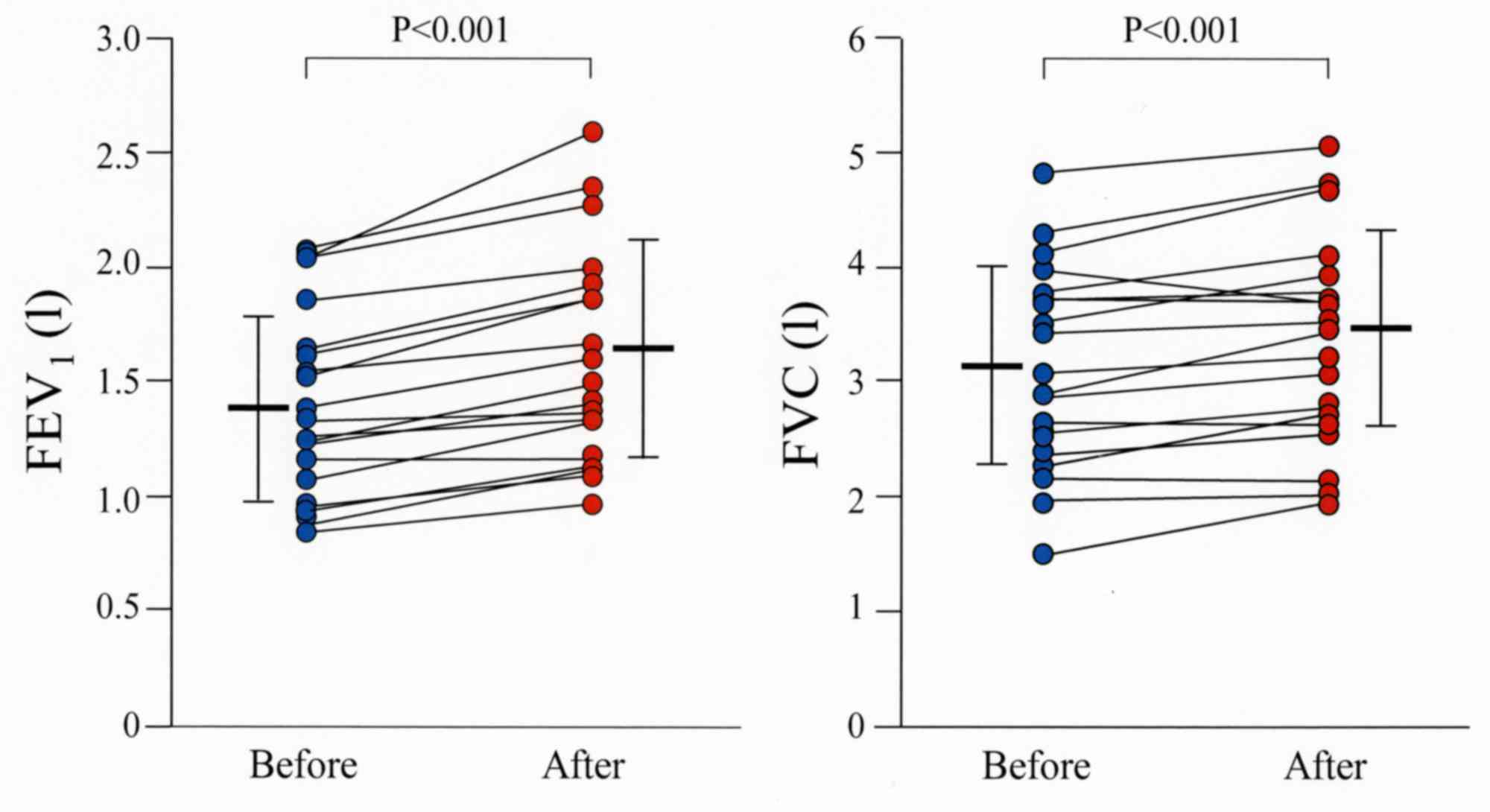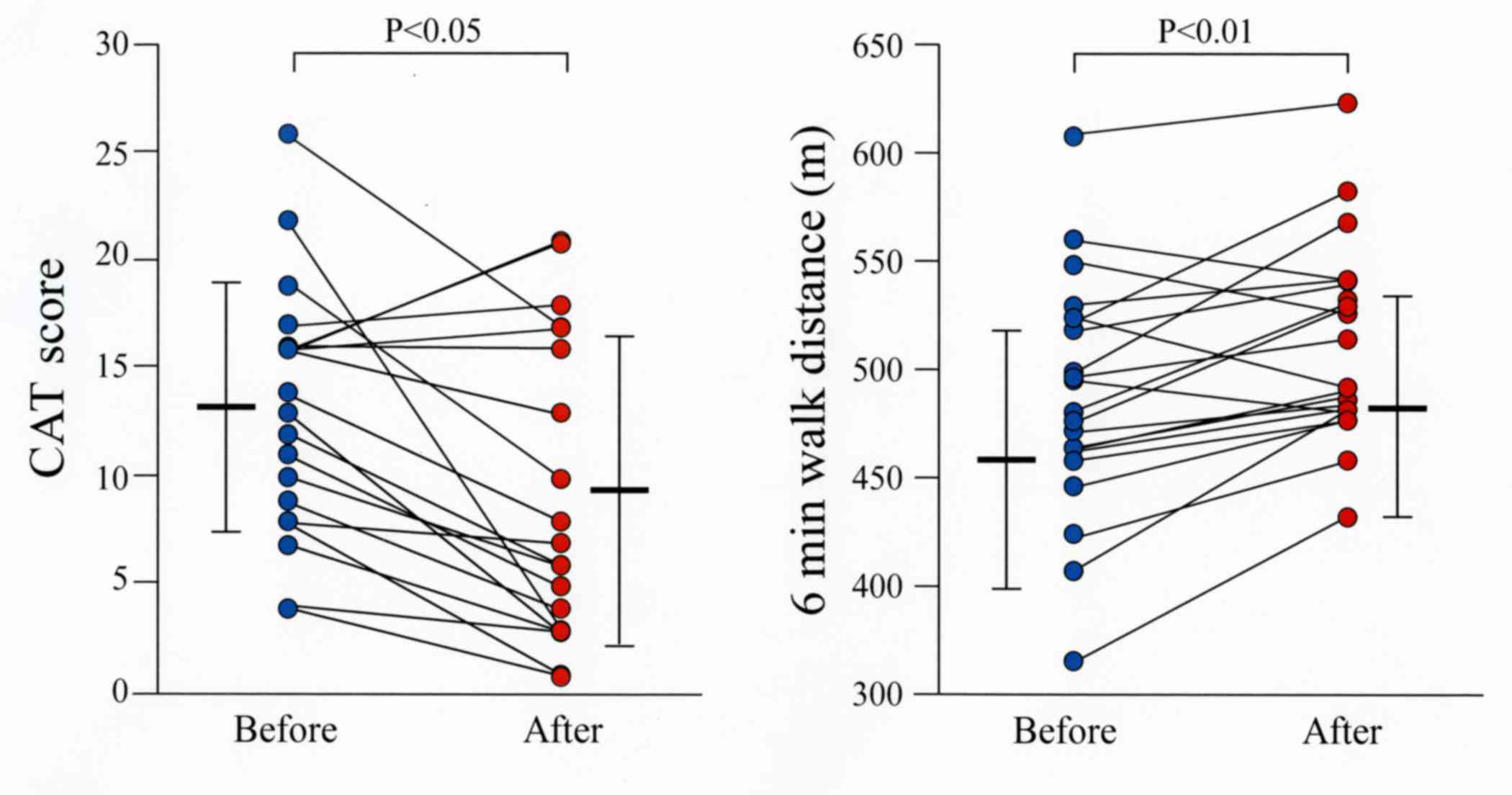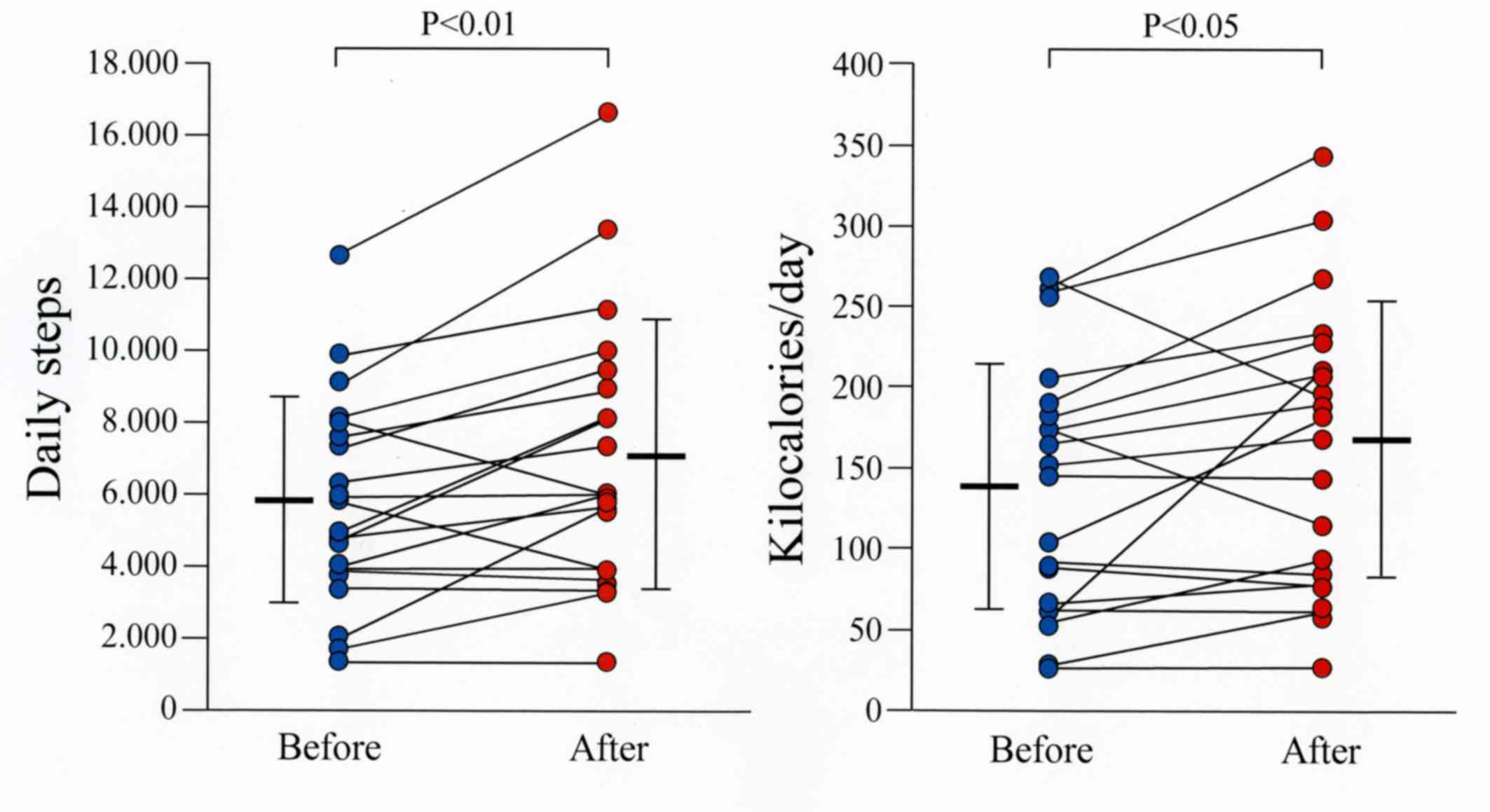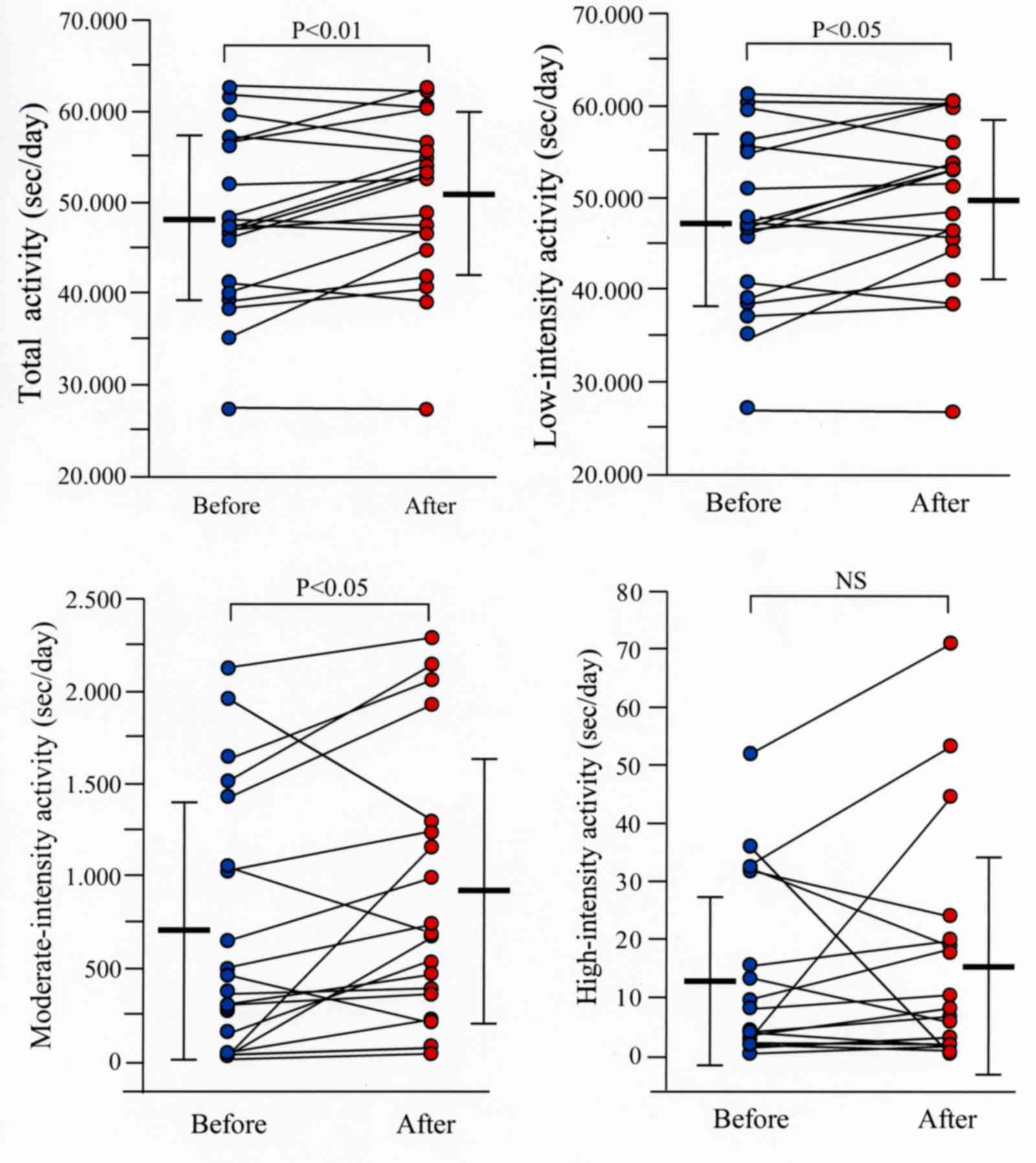Smart watch‑based coaching with tiotropium and olodaterol ameliorates physical activity in patients with chronic obstructive pulmonary disease
- Authors:
- Published online on: September 1, 2017 https://doi.org/10.3892/etm.2017.5088
- Pages: 4061-4064
-
Copyright: © Hataji et al. This is an open access article distributed under the terms of Creative Commons Attribution License.
Abstract
Introduction
In general, habitual and daily physical activity has been associated with a healthy status, prolonged life expectance and reduced prevalence of chronic diseases (1,2). The grade of physical activity is also an important determinant factor of the clinical condition, progression and outcome in patients with chronic obstructive pulmonary disease (COPD) (3–5). Patients with COPD with reduced physical activity have been demonstrated to have a rapid decline of pulmonary function, weakened and reduced limb muscle mass, frequent hospitalizations, poor quality of life and worse prognosis compared to patients with an active lifestyle (3–5). Therefore, one of the main goals of COPD therapy is to increase the physical participation during daily life activity.
The long-acting muscarinic antagonists (LAMAs) and the long-acting β2-agonists (LABAs) are bronchodilators that are presently recommended in clinical practice (6,7). The LAMA tiotropium and the LABA olodaterol, that require only once-a-day administration, have been indicated to be very effective at improving the clinical outcome in COPD (6,7). As inhaled bronchodilators are currently the mainstay for long-term maintenance therapy of patients with COPD with moderate to severe disease and combination of bronchodilators with different mechanisms of action may enhance efficacy and reduce the possibility of adverse events, clinical trials with combination of a fixed dose of tiotropium and olodaterol have been conducted, and the results have revealed significant improvement in parameters of pulmonary function tests and quality of life in comparison with each mono-component drug (6–9). However, whether this combined therapy may ameliorate the physical performance of patients with COPD remains elusive.
In the present investigation, the physical activity of patients with COPD before and after a combined therapy with tiotropium and olodaterol under a smart watch-based encouragement system was evaluated and compared.
Patients and methods
Patients
A total of 20 patients with COPD (18 males and 2 females; mean age, 70.3±6.4 years; age range, 58–83 years) with stable disease followed up at the Respiratory Center of Matsusaka Municipal Hospital (Matsusaka, Japan) from February-April 2016 were enrolled in the present study. COPD was diagnosed following the criteria of the American Thoracic Society (9). A volume-type spirometer (Super Spiro, DISCOM-21FX III; Chest M.I., Inc., Tokyo, Japan) was used to measure lung function parameters, including forced expiratory volume in 1 sec (FEV1) and forced vital capacity (FVC). The protocol and criteria for the 6-min walk test (6MWT) and the COPD Assessment Test (CAT) were previously described (10,11). All subjects provided informed consent prior to initiation of the study. The protocol was approved by the Matsusaka Municipal Hospital Ethics Board for Clinical Investigation (approval no. 150304-2-2) and the study was undertaken following the principles of the Declaration of Helsinki (clinical registration no. UMIN 23583). Table I summarizes the clinical and functional parameters of the subjects. All eligible patients were ex-smokers and none of them were receiving any smoking cessation pharmacotherapy, home oxygen therapy or pulmonary rehabilitation.
Study protocol
All patients with COPD carried a Lifecorder (Suzuken Co., Ltd., Nagoya, Japan), a uniaxial accelerometer sensor, fixed to their belts during the entire study period of 4 weeks in order to record the daily physical activity, including the number of steps, energy expenditure and the walking distance. A smart watch (Apple, Inc., Cupertino, CA, USA) worn by the patients during the 4-week study was used to encourage exercise performance. A moderate grade of physical activity (number of steps) was set up in the smart watch based on the height and weight of the patients. When the patient's physical activity was below or near the established goal, the smart watch vibrated and provided real-time motivational cues in the form of text messages, for example ‘time to stand up and stay active for 1 min’ or ‘you are almost there.’ The patients were instructed to take fixed-dose combination of tiotropium (5 µg) + olodaterol (5 µg) once daily using the Respimat inhaler (Spiolto™, Respimat; Boehringer Ingelheim, am Rhein, Germany) during the last 2 weeks of the study period. Rescue therapy with short-acting β agonist was not used during the study. All patients received sufficient instruction on how to fix and use the devices in the morning when they woke up and to remove them at night.
Statistical analysis
Data were expressed as the mean ± standard deviation. The non-parametric Wilcoxon rank test was employed to assess the difference among the means of two variables. Statistical analyses were performed using the StatView 4.5 package for Macintosh (Abacus Concepts, Piscataway, NJ, USA). P<0.05 was considered to indicate a statistically significant difference.
Results
Lung function and symptomatic parameters
Comparative assessment of pulmonary function tests before and after treatment with combination therapy demonstrated a significant increase of FEV1 and FVC after 2 weeks (P<0.001; Fig. 1) in all treated patients. In addition to spirometric findings, symptom burden indicators, such as CAT, have also been recently recommended by the Global Initiative for COPD for follow-up and management of patients with COPD (7). The CAT score was significantly improved in all patients by combination therapy compared to values before initiation of the treatment (P<0.05; Fig. 2).
Physical activity parameters
The distance walked during the 6MWT was significantly increased in all patients following treatment compared to that before starting the combination therapy with tiotropium and olodaterol (P<0.01; Fig. 2). The number of steps, energy expenditure expressed in kilocalories and the metabolic equivalent of task (MET) from 1–9 METs (total activity), 1–3 METs (low-intensity activity), 4–6 METs (moderate-intensity activity) and 7–9 METs (high-intensity activity), were measured using the Lifecorder. The mean number of steps and the mean energy expended in kilocalories for all patients were significantly increased (P<0.01 and P<0.05, respectively) following treatment compared to the mean values before treatment (Fig. 3). The total, low-intensity and moderate-intensity activities were significantly higher (P<0.01, P<0.05 and P<0.05, respectively) following combination therapy than values before therapy (Fig. 4). No significant difference was observed in physical activity parameters when patients were under smart watch-based encouragement but without receiving combination therapy with bronchodilators (data not shown).
Discussion
To the best of our knowledge, the present study demonstrated for the first time that combination therapy with tiotropium + olodaterol administered once daily significantly ameliorates physical activity parameters, including 6-min walking distance, number of steps, energy expenditure and metabolic equivalent of task, in patients with COPD.
Accumulating evidence supports the critical importance of enhancing physical activity in COPD (12). One strong illustrative example is the reported beneficial effects of the formal pulmonary rehabilitation program on health status, exercise performance and life expectancy of patients with COPD (13,14). Unfortunately, pulmonary rehabilitation is not accessible to all patients as it is costly, time-consuming and requires an interdisciplinary professional team and special facilities (15–17). Therefore, alternative methods, including pharmacological and non-pharmacological approaches, have been undertaken to encourage physical activity in patients with COPD (18). LABA and LAMA are included among the pharmacological approaches. However, despite the beneficial effects of LABA or LAMA on subjective symptoms, pulmonary function and quality of life, the impact of LABA or LAMA on daily life physical activity in patients with COPD is controversial (19,20). Short-term studies have demonstrated amelioration of physical activity by individual bronchodilators; however, long-term clinical trials have shown no effect (19,20). Non-pharmacological incentives, including the use of pedometers, phone calls, web-based support or smartphone-based activity stimulators, have also been trialled but without any conclusive results (21–24).
In the present study, to further address this question, a combined pharmacological and non-pharmacological approach was used to motivate physical activity in patients with COPD. In the present study, the patients were encouraged to be physically active by a smart watch-based coaching system during the period they were being treated with a combination of tiotropium + olodaterol. Through this dual approach using a smart watch-based alarm and a drug containing both LAMA + LABA, the patients demonstrated significant improvement in daily life physical activity.
In conclusion, the present study demonstrated that a smart watch-based coaching system in combination with tiotropium and olodaterol has a favorable impact on patients with stable COPD by increasing their physical activity level.
Acknowledgements
OH has received honorarium for lectures from Boehringer Ingelheim.
References
|
Kohl HW III, Craig CL, Lambert EV, Inoue S, Alkandari JR, Leetongin G and Kahlmeier S: Lancet Physical Activity Series Working Group: The pandemic of physical inactivity: Global action for public health. Lancet. 380:294–305. 2012. View Article : Google Scholar : PubMed/NCBI | |
|
Lee IM, Shiroma EJ, Lobelo F, Puska P, Blair SN and Katzmarzyk PT: Lancet Physical Activity Series Working Group: Effect of physical inactivity on major non-communicable diseases worldwide: An analysis of burden of disease and life expectancy. Lancet. 380:219–229. 2012. View Article : Google Scholar : PubMed/NCBI | |
|
Benzo RP, Chang CC, Farrell MH, Kaplan R, Ries A, Martinez FJ, Wise R, Make B and Sciurba F: NETT Research Group: Physical activity, health status and risk of hospitalization in patients with severe chronic obstructive pulmonary disease. Respiration. 80:10–18. 2010. View Article : Google Scholar : PubMed/NCBI | |
|
Garcia-Rio F, Rojo B, Casitas R, Lores V, Madero R, Romero D, Galera R and Villasante C: Prognostic value of the objective measurement of daily physical activity in patients with COPD. Chest. 142:338–346. 2012. View Article : Google Scholar : PubMed/NCBI | |
|
Pitta F, Troosters T, Probst VS, Spruit MA, Decramer M and Gosselink R: Physical activity and hospitalization for exacerbation of COPD. Chest. 129:536–544. 2006. View Article : Google Scholar : PubMed/NCBI | |
|
Buhl R, Maltais F, Abrahams R, Bjermer L, Derom E, Ferguson G, Fležar M, Hébert J, McGarvey L, Pizzichini E, et al: Tiotropium and olodaterol fixed-dose combination versus mono-components in COPD (GOLD 2–4). Eur Respir J. 45:969–979. 2015. View Article : Google Scholar : PubMed/NCBI | |
|
Ferguson GT, Fležar M, Korn S, Korducki L, Grönke L, Abrahams R and Buhl R: Efficacy of tiotropium + olodaterol in patients with chronic obstructive pulmonary disease by initial disease severity and treatment intensity: A post hoc analysis. Adv Ther. 32:523–536. 2015. View Article : Google Scholar : PubMed/NCBI | |
|
Vestbo J, Edwards LD, Scanlon PD, Yates JC, Agusti A, Bakke P, Calverley PM, Celli B, Coxson HO, Crim C, et al: Changes in forced expiratory volume in 1 sec over time in COPD. N Engl J Med. 365:1184–1192. 2011. View Article : Google Scholar : PubMed/NCBI | |
|
Rabe KF, Hurd S, Anzueto A, Barnes PJ, Buist SA, Calverley P, Fukuchi Y, Jenkins C, Rodriguez-Roisin R, van Weel C, et al: Global strategy for the diagnosis, management, and prevention of chronic obstructive pulmonary disease: GOLD executive summary. Am J Respir Crit Care Med. 176:532–555. 2007. View Article : Google Scholar : PubMed/NCBI | |
|
ATS Committee on Proficiency Standards for Clinical Pulmonary Function Laboratories: ATS statement: Guidelines for the six-minute walk test. Am J Respir Crit Care Med. 166:111–117. 2002. View Article : Google Scholar : PubMed/NCBI | |
|
Mackay AJ, Donaldson GC, Patel AR, Jones PW, Hurst JR and Wedzicha JA: Usefulness of the Chronic Obstructive Pulmonary Disease Assessment Test to evaluate severity of COPD exacerbations. Am J Respir Crit Care Med. 185:1218–1224. 2012. View Article : Google Scholar : PubMed/NCBI | |
|
Vaes AW, Garcia-Aymerich J, Marott JL, Benet M, Groenen MT, Schnohr P, Franssen FM, Vestbo J, Wouters EF, Lange P and Spruit MA: Changes in physical activity and all-cause mortality in COPD. Eur Respir J. 44:1199–1209. 2014. View Article : Google Scholar : PubMed/NCBI | |
|
Dodd JW, Hogg L, Nolan J, Jefford H, Grant A, Lord VM, Falzon C, Garrod R, Lee C, Polkey MI, et al: The COPD assessment test (CAT): Response to pulmonary rehabilitation. A multicentre, prospective study. Thorax. 66:425–429. 2011. View Article : Google Scholar : PubMed/NCBI | |
|
Lacasse Y, Goldstein R, Lasserson TJ and Martin S: Pulmonary rehabilitation for chronic obstructive pulmonary disease. Cochrane Database Syst Rev: CD003793. 2006. View Article : Google Scholar | |
|
Casaburi R and ZuWallack R: Pulmonary rehabilitation for management of chronic obstructive pulmonary disease. N Engl J Med. 360:1329–1335. 2009. View Article : Google Scholar : PubMed/NCBI | |
|
Nici L, Donner C, Wouters E, Zuwallack R, Ambrosino N, Bourbeau J, Carone M, Celli B, Engelen M, Fahy B, et al: American thoracic society/european respiratory society statement on pulmonary rehabilitation. Am J Respir Crit Care Med. 173:1390–1413. 2006. View Article : Google Scholar : PubMed/NCBI | |
|
Yohannes A, Stone R, Lowe D, Pursey N, Buckingham R and Roberts C: Pulmonary rehabilitation in the United Kingdom. Chron Respir Dis. 8:193–199. 2011. View Article : Google Scholar : PubMed/NCBI | |
|
Davis AH: Exercise adherence in patients with chronic obstructive pulmonary disease: An exploration of motivation and goals. Rehabil Nurs. 32:104–110. 2007. View Article : Google Scholar : PubMed/NCBI | |
|
Nishijima Y, Minami S, Yamamoto S, Ogata Y, Koba T, Futami S and Komuta K: Influence of indacaterol on daily physical activity in patients with untreated chronic obstructive pulmonary disease. Int J Chron Obstruct Pulmon Dis. 10:439–444. 2015.PubMed/NCBI | |
|
Watz H, Krippner F, Kirsten A, Magnussen H and Vogelmeier C: Indacaterol improves lung hyperinflation and physical activity in patients with moderate chronic obstructive pulmonary disease-a randomized, multicenter, double-blind, placebo-controlled study. BMC Pulm Med. 14:1582014. View Article : Google Scholar : PubMed/NCBI | |
|
Mendoza L, Horta P, Espinoza J, Aguilera M, Balmaceda N, Castro A, Ruiz M, Díaz O and Hopkinson NS: Pedometers to enhance physical activity in COPD: A randomised controlled trial. Eur Respir J. 45:347–354. 2015. View Article : Google Scholar : PubMed/NCBI | |
|
Moy ML, Weston NA, Wilson EJ, Hess ML and Richardson CR: A pilot study of an Internet walking program and pedometer in COPD. Respir Med. 106:1342–1350. 2012. View Article : Google Scholar : PubMed/NCBI | |
|
Tabak M, Brusse-Keizer M, van der Valk P, Hermens H and Vollenbroek-Hutten M: A telehealth program for self-management of COPD exacerbations and promotion of an active lifestyle: A pilot randomized controlled trial. Int J Chron Obstruct Pulmon Dis. 9:935–944. 2014. View Article : Google Scholar : PubMed/NCBI | |
|
Wewel AR, Gellermann I, Schwertfeger I, Morfeld M, Magnussen H and Jörres RA: Intervention by phone calls raises domiciliary activity and exercise capacity in patients with severe COPD. Respir Med. 102:20–26. 2008. View Article : Google Scholar : PubMed/NCBI |













